On The Record with Pete Snyder, Head Coach for the 1979 UC Santa Barbara Men’s Water Polo Team
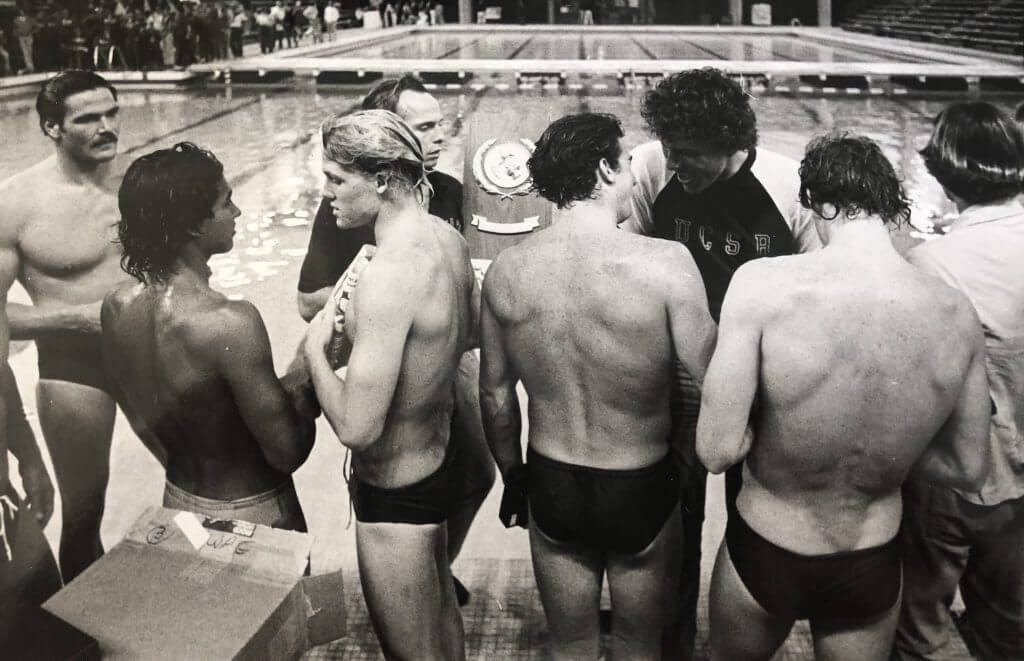
The current men’s NCAA Water Polo season is one of the most competitive in recent memory: With only a few weeks remaining in the regular season, all the conferences have pivotal games ahead, and parity seems to be the norm. One of the breakout teams this season is UC Santa Barbara. Wolf Wigo’s squad won their first 15 games to open the season and ascended to the top of the Collegiate Water Polo Association varsity poll for a few weeks in September. To reach this never-before conquered peak, the Gauchos upset then #1 USC (for the first time since 1990), and #1 Stanford five days later. UCSB has also beat California twice. Currently, the 4th-ranked Gauchos record stands at 18-5, and their season-opening win streak broke a program record set by the 1979 edition of the team which also captured the national championship.
[Remembering the Remarkable ’79 UCSB Gauchos—NCAA Men’s Water Polo Champs]
It’s been 40 years since the Gauchos reached the pinnacle of success in NCAA Water Polo, and given the recent resurgence of the program, it makes sense to review the historic run with Pete Snyder, the head coach of that ’79 team. Coach Snyder spent 17 years at the helm of UCSB, was a two-time NCAA coach of the year, mentored more than 35 All Americans, and led the team to four 20-win seasons and seven NCAA tournament appearances. He is enshrined in the UCSB Athletics Hall of Fame.
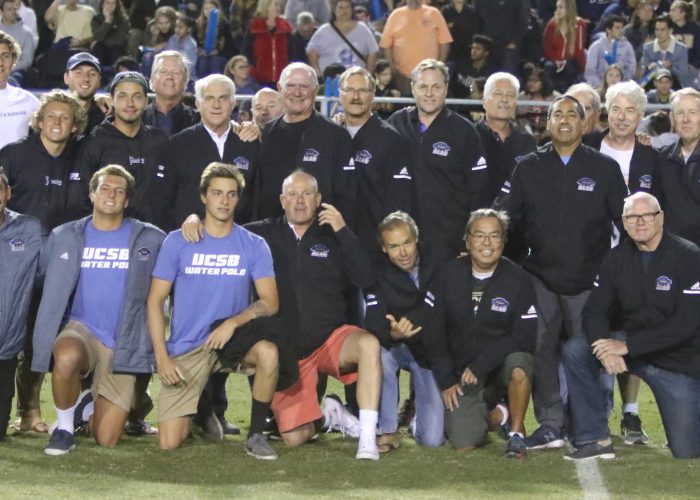
The 1979 NCAA champs feted last month at a Gauchos’ soccer match. Photo Courtesy: UCSB Athletics
Swimming World had the opportunity to speak with Pete about the 1979 team and its characteristics and accomplishments. Several team members achieved continued success upon graduation: Goalie Craig Wilson evolved into arguably the best goalie in the world, earning 2 silver medals in 3 Olympic Games. NCAA MVP Greg Boyer enjoyed a stellar career on the US National team, also earning Silver in 1988 Olympics and appearing in the 2000 Olympics as a Referee. John Dobrott was a mainstay on the Gaucho team and earned a Gold medal in the World Student Games in 1979. Guy Baker won six NCAA titles as a coach at the UCLA—three with the men and three with the Bruin Women—and led the USA Women’s team to three medals in three Olympics. Aaron Chaney went on to great success as a high school coach and whistled the 2004 Olympics as well.
With all this as backdrop, we asked Pete about the 1979 season in general and that once-in-a-lifetime NCAA tournament run in particular.
– You’ve been around the sport for a long time and—unlike peers that you’ve coached against—you’re still teaching and coaching.
At this juncture, I am a full-time faculty member and professor at Fullerton College. I have to finish my sort of workload there basically to still get some benefits for my pension, but also to be able to sort of segue back to my home which is Santa Barbara.
So, that’s actually where I’m talking from right now—in Santa Barbara. But prior to that, I had 20 years at Fullerton College. I felt very fortunate to get hired. I did adjunct coaching/teaching at the Foothill College which was my alma mater before Stanford, and it’s also where I met my wife, Becky, and also from that point it was basically 50/50 in many regards.
My first 18+ years, I did a very small stint at a high school up north, Gunn High School, and then 18 years at UCSB. I did a little bit of work in administration to build my resume. I worked at the 1996 Olympics, and then after the Olympics I was hired on, fortunately, by Fullerton College. It has a long history of aquatics, and half way about six years ago or more, we had a brand-new facility built, which is very nice.
I am not coaching there. I’m just teaching. I am doing some volunteer work with Santa Barbara City College with Chuckie and Brian Roth. Don’t know what the best expression would be, but I can certain say the coaches have a tendency to want to get that fix you know.
Particularly, I real enjoyed Chuckie. He’s a great young coach. Very receptive to new things. It is exciting and invigorating—as you well know.
– Are you still doing referee evaluations?
Oh, yes.
– Because where I used to see you most was on those assignments.
I’m trying to keep my impartiality, obviously, and sort of work up through it. If there are ranks, I don’t think we really have ranks. We’re all evaluators. But, I’m happy to see that Bob [Corb] made it so that all the evaluators weren’t referees. We have some ex-coaches on there. I really enjoyed that as well because it’s good to see all levels and see what our future is in our sport and it looks pretty good.
[On The Record with Bob Corb, NCAA National Coordinator of Water Polo Officials]
– I can’t believe it’s been 40 years since the ‘79 season. My guess is you have pretty good memories of it—as you get into August and you’re getting your team together what was your outlook for the team?
Well, as you hit it on the head, 1979 was a building process that didn’t just happen during the fall. We had a very rigorous off season which I think laid the groundwork for our kids to get better and to mature in the sport. We had a couple of red shirts, Dave Hendrickson and Greg Boyer, who didn’t play in ’78 and had an extra year in ’79. And so, the behind the scenes thinking was we’ve got a pretty good team now. we’ve got this goalie [Craig Wilson] we found [him] or he found us. They’re pretty smart and I think that it was the right decision. Obviously, in hindsight for sure it was the right decision.
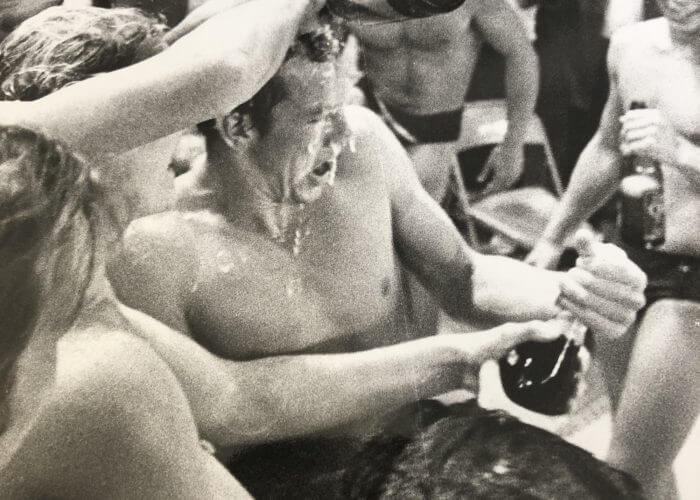
Celebration! Photo Courtesy: Pete Snyder
Prior to that fall of ’79, I had individual meetings with every player on the team, and of course, the number one goal was: we want to win an NCAA Championship and we feel we’re capable of it. So if you want to set goals, they were there. I didn’t have to coax anybody or try and convince anyone of being a valid powerhouse—we were ready to take on everybody in the fall.
– You mention Boyer and Hendrickson; that team had three first team All-Americans: goalie Craig Wilson, John Dobrott and Boyer. But it also a bunch of guys who were good players: Mike Yates, Steve Mitchell, and Dave Phillips. How did you manage your depth?
Again, there’s an experiential factor on this. We not only had a “Santa Barbara A” in all those tournaments, but we also had a B-team. The B-team was an integral part of our championship because they’re getting great experience. I was told not to bring this up, in pre-zone qualifications our B-team beat Westwood A. If you can imagine that. Our B goalie at the time was Bob Mark. That was the last game of the evening. I remember our kids were playing out of their minds basically. I know he probably had at least 15 blocks. But the point being, this was great experience in building confidence for that whole group.
I haven’t seen Wolfie’s team yet this year, but—particularly at Santa Barbara—you’ve got to build a critical mass of players, good players. And that takes time.
[On Deck with Danny Roland, UC Santa Barbara Men’s Water Polo Goalie]
The type of kids that typically go to UCSB, I don’t know that athletics is their number one priority. It’s not like it has a huge athletic tradition. You have to find unique kids that fit that particular environment and you got to build them.
Let’s see. Guy Baker. He played a year at a community college. I think they get overlooked a lot of times and everyone worries about well you only get them for a couple of years. Oh really, you can have them for three years if one red-shirts for a year. For us it was really important to attract those kinds of players.
Our practices were intense. Everyone was playing for a goal and willing to sacrifice anything—sacrifice individual accolades for the team to win.
– You mention that in the ’70s and ’80s spring and summer ball was part of every college program. You could play 35 games if you entered all the tournaments and then pre-zone, zones and nationals. One thing that has always stuck in my mind is that’s where your B-team players could get game experience, and develop. Whereas now, if you’re not in the rotation on a college team, I don’t know where you’re going to get the opportunity to play.
I remember sitting in a meeting and discussing this exact issue with Bill Barnett, our national [team] coach. Because what was happening was our graduates—and it’s still happening obviously—where could they play? Where were they going to get experience? So, they started going to Europe.
Well, okay that’s good for them, but it’s not good for the kids back here in the United States that would really stand to benefit by playing against older players. You know one game of having my kids go against whoever it is. At the time it was Industry Hills, who had a lion’s share of the national team players. You’re not going to get that experience anywhere!
It was bad initially because coaches could only do so much. A lot of this was learned in the water going against players who’d been around for five, 10, maybe 15 years. Yeah, I definitely think that puts us at somewhat of a disadvantage. I think we try to squeeze too much out of kids at an early age and if they don’t make it, what’s left for them? You’re absolutely right, I don’t know.
– Let’s talk about Craig Wilson; you said: “Well we kind of found this guy or he found us”. He went on to play in three Olympics and at that time was considered the best goalie in the world. How did you challenge him to get better because he’s a unique individual?
I will say this much: part of being a good goalie is being unique. I think [Wilson] had his own personal quirks. Nothing really threatening to him training hard. He definitely was as good a practice player as anybody else in the water, but he just had all this talent. He was the fastest or second fastest guy on the team as a goalie. His ability to throw the ball all the way down field to start a counter attack, and of course, all of his shot blocking skills.
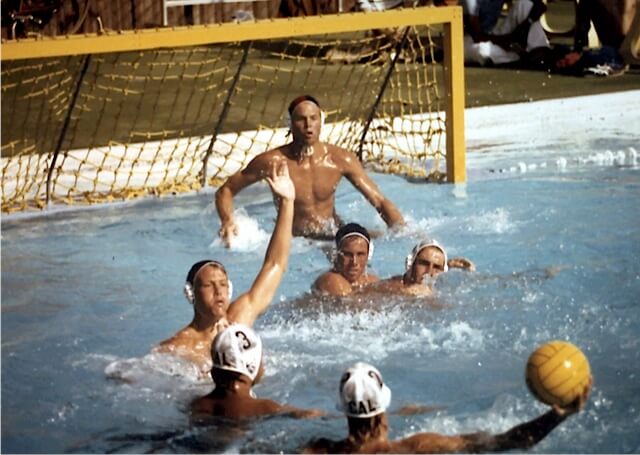
Craig Wilson stands tall in the Gaucho cage. Photo Courtesy: UCSB Athletics
I remember one time when we were playing against Newport A down at Newport Harbor High School and they had Joe Vargas, and I’d say half of their team were national team players. There was one time when there was a one on nobody and Craig laughed at the guy like a little chuckle. That just totally threw him off. I mean his confidence, whatever, he forgot about trying to score just went out the window. Craig snuffed him and we got the ball going back the other way.
He was like a diamond in the rough, you know. He didn’t want to stay at Davis and went to Santa Barbara City College. Actually, the guys said he’s playing inner tube water polo. He came out in the spring, then played his junior year all the way through. There was a competition there with another goalie; it didn’t take too long to figure out that he would be our number one goalie.
– It’s interesting to hear you say, he was as good a practice player as anyone. My experience with him is he was always really positive, really confident.
I have observed over time that the best goalies take time because they want to get in with somebody who’s a good shooter and take shots from them. For him, it was Boyer. Boyer would get in the water with Craig and try to beat him.
Obviously, it helped Boyer because he’s going against this great goalie, and it helps Wilson because Boyer is trying to find his weaknesses. I think that is the quality of a goalie that’s really going to show their wares at some point in time. They understand that’s its valuable to have somebody really good shooting on them.
– Greg Boyer was one of the dominant players of the era, and one who could play right now. Given his extraordinary talent, how did you manage him within the framework of the team?
Greg was a very level-headed, pretty modest in many respects. One of the things I did particularly with Greg—because he has kind of an interesting personality—I had to figure him out.
I will say this about Greg, he is without a doubt one of the most competitive people I’ve ever met. I remember one time he had his hand damaged, and it was his shooting hand. This was with the national team and it was bandaged, and he said: “You know, once we bandage that thing, it’s like a target for every other player on the other team.” But that didn’t phase him. Greg played, played well, and also was a student of the game.
– Let’s talk about the game you were playing in 1979. Thirty-meter course. A lot more emphasis on the counterattack and driving. Centers were primarily passers. There was an incentive to drive during dead time to draw fouls and to create extra-man opportunities. How did these rules influence how you coached?
In many respects, your offensive philosophies show what your defense can do, and what type of defense you’re running. Ours was a press defense and playing the passing lanes which lent itself to the fast break. I didn’t think we’re going to overwhelm at the two-meter position, with the exception of Greg and Spanky. Beyond those two guys, although Mike Yates did a good job, but I’ve always been of the philosophy that you want to try to involve as many of your players as possible and make sure that everybody in some way is a threat to score the ball.
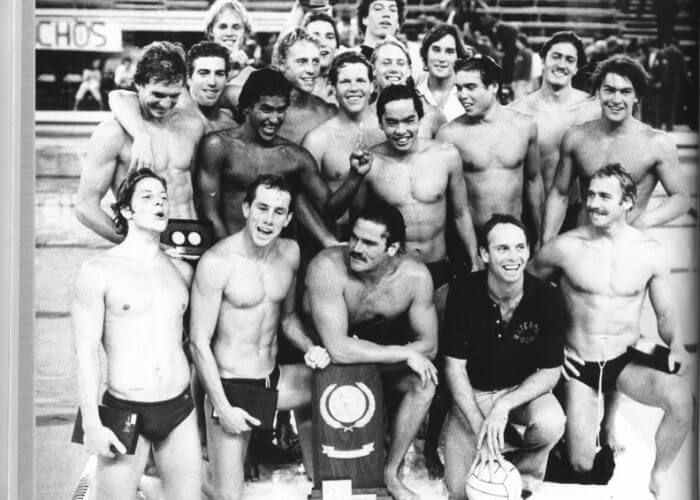
A moment never to be forgotten; Snyder in the dark shirt. Photo Courtesy: UCSB Athletics
David Phillips—a sophomore that year, I think. Just a great driver and shooter, not a two-meter specialist. He was a good decent defensive player, but for him it kind of be in the fold and be part of things, stand and kind of learn where and how David liked the ball. Because once you give him the ball, he’s another guy that scores from anywhere.
Skipping ahead a little bit to the championship game. I actually made a change in the line-up, I put Guy (Baker) in as a starter which I’m sure pissed some people off. But sometimes you have to do that because we needed somebody and our lefties were not the best in terms of making a steal [or] making assists from a six spot on 6 on 5. Guy was really good at that–It worked!
– It showed a lot of confidence in him and it’s an interesting move. Going back to the semifinal, did you make similar adjustments to play Stanford—which had beaten and tied you in the regular season?
I think our team had confidence. Stanford had gone ahead of us a little earlier in the game. Sometimes they were so good, but I would tell you they were very young to be… something like four or five championships in a row. They were young players at that point in time, and we were pretty much very much loaded with seniors.
So, that experience helped. I just think that the guys emotionally were at a level where they felt they could beat Stanford, and I think that’s the biggest thing is just having the confidence.
– And it was a one goal game, right—and you said you were behind early, right?
Not by a lot… At halftime, we were down by a goal. Which I thought was okay because I still was confident. I think you did ask about how far we went down on the bench. I thought it was three, maybe four in that game. In the championship game, I was able to go a little bit deeper because we got a pretty big lead.
– That championship game was not close. You had beaten the Bruins three times during the season—once by six and twice by four. You were clearly a better team. How did you keep them from being over confident?
There is a subtle difference between being cocky, over confident, and confident. That was definitely something that I tried to emphasize. I never came out and said anything about the fact that this is UCLA, blah, blah, blah.
[Dettamanti on 50 Years of NCAA Men’s Water Polo Championships]
We’re pretty good ourselves. We need to show that. We need to be confident and so forth. But by the same token, I didn’t want them to get over confident. I don’t think they were. There was enough on the line to where the edge was still there.
– My last question is open-ended. As you look back on that team, I know you spent 17 years at Santa Barbara and you still live there—it’s obviously home, and you had a great career there. As you look back on that group you coached, what’s was most meaningful?
I’m certainly proud of all the players. It does say something that there are only a couple of teams on the UCSB campus that won championships. Our volleyball team has been to the finals. The men’s volleyball team a number of times, but never came away with a championship.
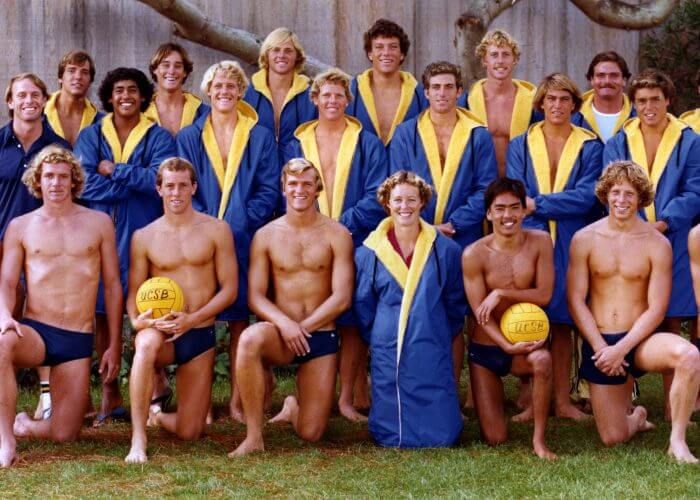
The 1979 team portrait. Photo Courtesy: John Dobrott
They were a fun group. Very challenging in some respects, but that sometimes goes with the territory. They push the edge a little bit, that means that they’re maybe going to take a few more chances they wouldn’t take. Many times that comes out for the better.
Probably the most important thing I was shocked at [is], regardless of where someone was from or what their pedigree was, everybody sacrificed for one goal. Regardless of what the endeavor is, if you have everybody going in the same direction, paddling the same way—If everybody is doing that, then it really makes a difference.



